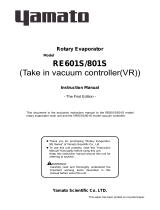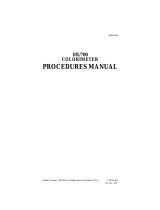
Product Information
ADU 5 – Dry Point Sensor
Table of Contents
1 ADU 5 – Dry Point Sensor ..................................................................................................................................... 1
1.1 Scope of Delivery ................................................................................................................................................................................ 1
2 Installing the Dry Point Sensor .............................................................................................................................. 1
1 ADU 5 – Dry Point Sensor
The optional dry point sensor kit is required for the automatic dry point detection for the distillation of solvents.
Depending on the standard and the sample to be tested two different dry point sensor kits are available:
Material no. 106631, dry point sensor kit for 200 mL distillation flasks
Material no. 106632, dry point sensor kit for 100 mL/125 mL distillation flasks
1.1 Scope of Delivery
Dry point sensor with centering holder for Pt100 sample temperature sensor (Pt100 not included)
2 Installing the Dry Point Sensor
Please refer to your ADU 5 Instruction Manual for safety instructions and general handling instructions.
The dry point sensor is pre-installed in a stopper for the distillation flask and cannot be removed from this stopper.
CAUTION: Take care when handling the Pt100 sample temperature sensor as the glass body might
break and cause injuries.
To install the dry point sensor follow these steps:
1. Select the correct dry point sensor which matches the size of the distillation flask to be used.
2. Select the distillation flask and keep ready.
3. If required, unplug the Pt100 sample temperature sensor from the ADU 5.
4. Loosen the screw cap from the centering holder and pull out the Pt100.
5. Carefully insert the Pt100 sample temperature sensor into the opening in the stopper of the dry point sensor.
TIP: If you use a thin film of glycerin on the O-ring of the dry point sensor, the sample Pt100 can be inserted more
easily. Make sure you clean the sample Pt100 after the insertion!
NOTICE: If the Pt100 is still difficult to insert even though glycerin has been applied to the O-ring of the dry point
sensor, loosen the three screws at the top of the stopper slightly (do not unscrew completely!), insert the Pt100
and tighten the screws again. The screws apply pressure to the O-ring thus changing the diameter of the opening.
Fig. 1 – Dry point sensor, side view
Fig. 2 – Dry point sensor, seen from above
Location of the
three Phillips
screws
www.anton-paar.com | Created by Pütz, Dunja on 3 May 2017 | H15IE009EN-A_ProdInfo_ADU5_DryPointSensor.docx page 1 of 2

Product Information
ADU 5 – Dry Point Sensor
6. Insert the sensor assembly fully into the empty distillation flask. Note that the Pt100 sample temperature
sensor is turned to the rear, so that it is positioned directly in front of the side arm opening (see figure 1
below).
7. Position the dry point sensor in the center of the flask bottom. Make sure that the sensor rests on the bottom
of the flask!
TIP: The tip of the dry point sensor must be suspended on the bottom of the flask and give slightly. If this is not
the case, try to bend the tip a little bit and very carefully.
8. Adjust the height of the Pt100 so that the top of the very fine spiral wire at the end of the Pt100 should be
exactly aligned with the mark on the distillation flask (for the correct position refer to the ADU 5 instruction
manual).
9. Take out the dry point sensor assembly from the distillation flask and store it in the test glass at the top of the
ADU 5.
10. Connect the dry point sensor plug and the Pt100 sample temperature sensor plug at the rear of the ADU 5.
Fig. 3 - Correct position of Pt100 and dry point sensor
Fig. 4 - Location of Pt100 and dry point sensor connector at the rear
of the ADU 5
Follow the instructions in your ADU 5 Instruction Manual for the activation of the dry point sensor and the
preparation and execution of the distillation.
NOTICE: Do not add boiling stones when using the dry point sensor kit.
Contact us at
Anton Paar ProveTec GmbH
www.anton-paar.com
Dry point
sensor
connector
Pt100
connector
www.anton-paar.com | Created by Pütz, Dunja on 3 May 2017 | H15IE009EN-A_ProdInfo_ADU5_DryPointSensor.docx page 2 of 2
/








